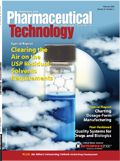AIM-less
If at first the product fails, then inspect, inspect again
Inspect until good
"One particular injectable product was made and filled into a dual chamber, hourglass shaped container," recalls our GMP Agent-in-Place. "There was a stopper at the waist of the hourglass and again at the neck opening. The chambers stored different materials that would tend to interact and degrade faster if they were filled as a mixture. But they had to be mixed before usage. To mix the two chambers, the middle stopper had to be dislodged. The upper stopper was very long, so it could be pushed down enough to produce sufficient air pressure on the upper chamber to force the short middle stopper into the lower chamber. Thus, the middle stopper had to have been moveable. To make it mobile, it was heavily siliconed, which acted almost like a grease.

"The siliconing process often resulted in excess silicone being applied, which then sloughed off into the solution. The filled vials were inspected for particulates with an automatic inspection machine (AIM) that rejected many vials because of silicone globules in the solution.
"Because silicone was thought not to be a safety concern, the rejected vials were reinspected. The second and third times through, fewer vials were rejected, and the vials accepted through the second and third inspections would be released. The AIM would accept the silicone vials on the additional passes because the extra spinning and handling would dissolve the silicone in the injection solution (which included emulsifier-like ingredients).
"In the mid-1980s, we had an FDA inspection that looked at the inspection process. The reinspection process was considered objectionable because the endpoint and the allowable number of reinspections were not clearly specified in the SOPs [standard operating procedures]. In addition, the reinspection was known to accept some particulates as well because any AIM inspection is probabilistic in nature. That is to say that the rejection mechanism was not black and white, there was a probability that particulates would be accepted or rejected. Larger particles would be rejected more often. In addition, there was inadequate investigation and corrective actions put into place to correct the base problem of silicone in the vials.
"As a result, we started the lengthy process of replacing the stopper, which was really the base issue. But I think the final resolution was that we sold the product line."
Cottonphobic
"It was sort of funny," our GMP Agent-in-Place chuckles. "In our stability group, the sample clerk had a phobia of the cotton packing used in the top of the bottles for tablets and capsules. She didn't like the feel of the material, so she always used tools to open the seal of the sample bottles and a long forceps to pull out the cotton, which was quickly trashed.
"So our prankster took some of the cotton packing and put it in the pockets of her lab coat. The next time she wore the coat she reached into her pockets for the keys to the storage cabinet and found the packing. She screamed, tore off her lab coat, then yelled at all of us asking who could have done it!"
Quotes
Here are two of my favorite quotes from one of my former site managers:
"Quality—always decisive, always wrong."
"What we need is a one-handed quality guy. Instead, we have someone who says 'on one hand.... and then again, on the other hand....'"
Do you have any favorite quotes? Send them to us at AgentinPlace@advanstar.com
Pharmaceutical Technology's monthly "Agent-in-Place" column distills true-life cautionary tales from the secret files of Control, a senior compliance officer. If you have a story of clueless operators, oblivious management, inopportune lapses of judgment, or Murphy's Law in action, please send it to Control at AgentinPlace@advanstar.com We won't use any names, but if we do use your tale of disaster, courage, or just plain weirdness, Control will send you a coveted Pharmaceutical Technology t-shirt.
